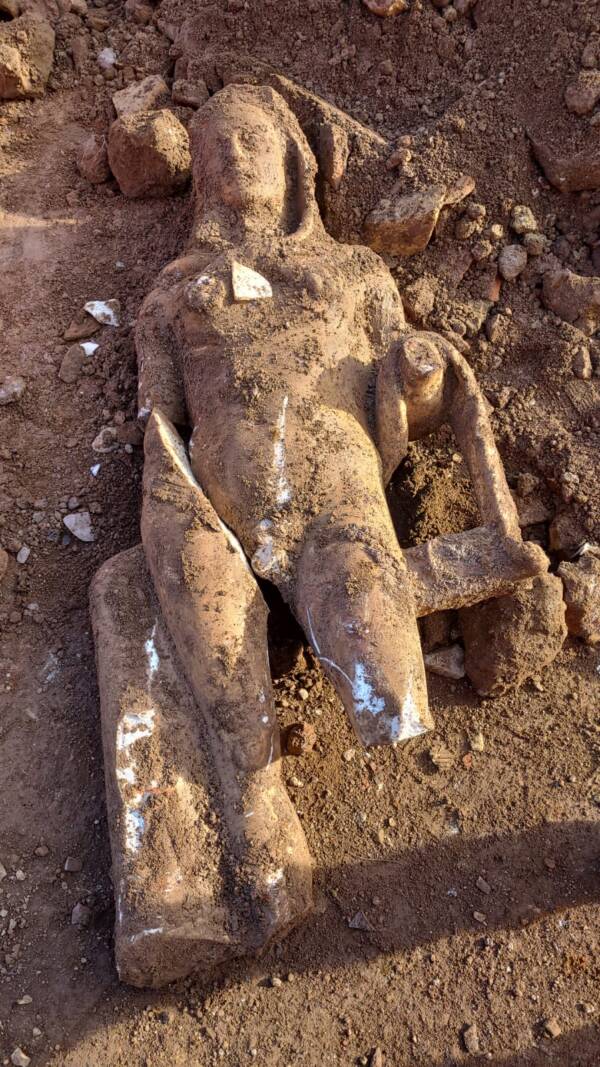Experts believe that the statue may depict Hercules or perhaps a Roman emperor dressed as the ancient hero.

Parco Regionale dell’Appia Antica/FacebookThe Hercules statue appears to date back to the Roman imperial period, 27 B.C.E to 476 C.E.
History hums beneath the city of Rome. In the latest exciting archaeological find from the heart of the bygone Roman Empire, archaeologists have discovered a statue of a Hercules-like figure, draped in a lion’s cloak, while excavating an ancient sewer in the Appia Antica Park.
“Today, after weeks of reporting land movements completely devoid of archaeological interest, Parco Scott gave us a big surprise: a life-size marble statue that, due to the presence of the club and lion’s skin cloak covering its head, we can certainly identify with a character dressed as Hercules,” Il Parco Archeologico dell’Appia Antica wrote in a Facebook post.
According to The Guardian, the statue was discovered about 65 feet beneath the earth during repairs of a sewer along Rome’s ancient Appian Way. It appears to date from the Roman imperial period, 27 B.C.E to 476 C.E., but other details about the statue’s history are difficult to determine. It was apparently tossed in a trench during the sewer’s construction.
The Parco Archeologico dell’Appia Antica wrote on Facebook that without contextual evidence, archaeologists have had to rely on other context clues by studying similar artifacts.
“To get to the identification and chronology of the sculpture we therefore have to ‘look for comparisons’ by analyzing similar artifacts: one of the main post-excavation activities of the archaeologist,” the post explained.
This historic detective work led the archeologists to speculate that the statue may not depict Hercules himself, but a Roman emperor named Gaius Messius Quintus Traianus Decius, or Decio Traiano, dressed as Hercules.

Il Parco Archeologico dell’Appia Antica/FacebookA coin depicting Emperor Gaius Messius Quintus Traianus Decius next to the statue dressed like Hercules.
“The face of ‘our Hercules,’ although corroded, seems to share with the official portraits of Decio the ‘wrinkles of anxiety,’ which recall Republican Roman style and were aimed at representing the concern for the fate of the State, a virtue evaluated very positively in the high ranks of the empire,” the park explained. “Other characteristic features are the treatment of the beard… and the morphology of the eyes, nose, and lips.”
That said, the Parco Archeologico dell’Appia Antica also cautioned that more work needed to be done before experts could definitively state who the statue depicted.
“This is a very first guesswork,” they wrote. “[A]fter cleaning, additional elements will emerge that can confirm it or direct to other identifications. We are indeed examining all possibilities, including private portrait, always considering that our character, portrayed as Hercules, was most likely to be a prominent figure.”

Il Parco Archeologico dell’Appia Antica/FacebookThe statue is wearing Hercules’s famous lion-skin cloak, but archaeologists are still working to determine who the statue is supposed to depict.
As Heritage Daily explains, the Roman hero of Hercules is based on the Greek hero of Heracles. In both myths, he allegedly kills his wife and children after being driven insane by the goddess Hera. In order to atone for his sins, Hercules completes 12 impossible feats at the command of King Eurystheus.
Many Roman emperors like Commodus and Maximian admired Hercules. They identified themselves with his legend, worshipped him as a demigod, and even participated in Herculean cults. Perhaps Emperor Decius also sought to emulate Hercules by depicting himself in a statue wrapped in Hercules’s lion-skin cloak.
Though it’s too early to know for sure, archaeologists will continue to study the statue to see which ancient mysteries they can unravel.
After reading about the Hercules statue found in a Roman sewer, see how archaeologists discovered an ancient Roman “service station” in England while building a soccer field. Or, see how archaeologists found a Roman soldier’s 1,800-year-old face mask in the ancient city of Hadrianopolis.





